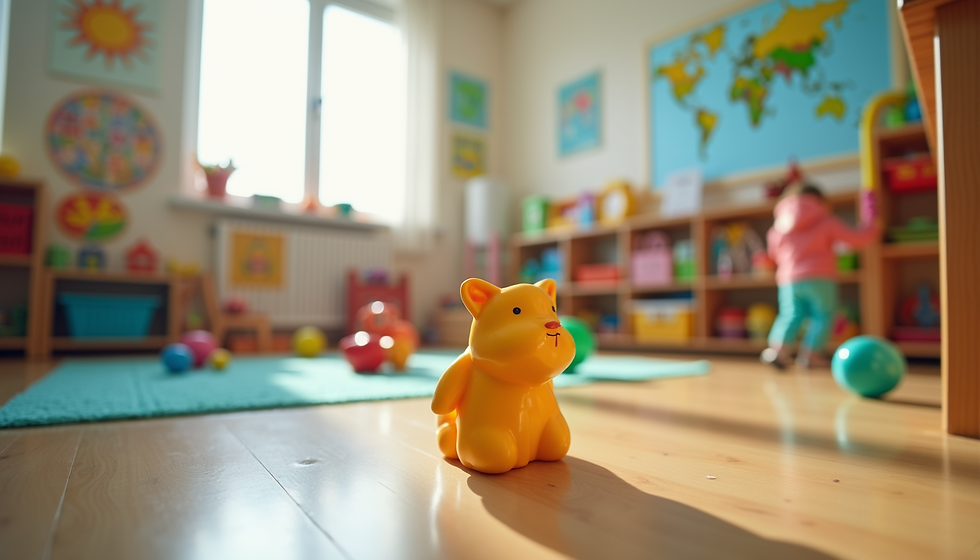Exploring the Positive Impact of Art Activities on Preschool Children's Development
- Laylee Bodaghee

- Jun 19
- 4 min read
Art is more than just a creative outlet; it’s a vital part of early childhood development. Incorporating art activities in preschool not only nurtures creativity but also fosters essential skills among young children. This post highlights the numerous benefits of art activities for preschool children's development.
Enhancing Motor Skills
Art activities significantly enhance motor skills among preschoolers. Activities such as painting, drawing, or molding clay help children develop fine motor skills as they learn to control their movements. For example, studies show that children who regularly engage in art projects improve their hand-eye coordination by 30% over several months.
The process of holding a paintbrush or safely using scissors requires coordination and precision. The repetitive motion involved in creating art reinforces muscle memory. These activities sharpen their ability to grasp and manipulate small objects, laying the groundwork for vital skills like writing.
Fostering Creativity and Imagination
Imagination is a fundamental aspect of childhood, and art provides a perfect medium for children to express their creative thoughts. In a supportive environment, preschoolers can explore colors, shapes, and materials, allowing them to construct their own narratives.
For instance, when children are encouraged to create freely, they learn valuable problem-solving and decision-making skills. Art activities promote experimentation with new ideas and materials, which stimulate imagination. A study found that children who engage in art regularly can think outside the box 50% more effectively than those who do not.
Boosting Emotional Expression
Art serves as an important outlet for emotional expression among preschoolers. Through various forms of art, children can externalize feelings they may not have the vocabulary to express. Creating a painting or molding clay allows them to show joy, sadness, frustration, or excitement.
Additionally, engaging in art-related activities helps children build a sense of identity. When they create something unique, it boosts their self-esteem and confidence. The act of creating can be therapeutic, providing children a safe space to explore their emotions and promoting overall emotional well-being.

Encouraging Social Skills
Art activities often promote collaboration among preschoolers. Whether they are working on a group project or sharing supplies, children learn to communicate and cooperate with their peers. This collaborative approach fosters vital social skills such as sharing, negotiation, and empathy.
As children work together on art projects, they also learn to respect others’ ideas and perspectives. This exposure to teamwork is crucial for building healthy social relationships, as they navigate challenges and celebrate successes together.
Supporting Language Development
Art activities can greatly enhance language development in preschoolers. When engaging in art, children frequently describe their creations, encouraging vocabulary growth and language use. For instance, while painting, they might ask questions or share stories about their art, facilitating valuable dialogues that strengthen their communication skills.
Moreover, storytelling through art prompts children to narrate their experiences, enhancing their narrative skills and comprehension. This connection between visual arts and language can significantly boost their overall communication abilities.
Cultivating an Appreciation for Culture
Art introduces preschoolers to diverse cultures and histories, broadening their understanding of the world. By exploring different artistic styles, children learn about various traditions and backgrounds. This cultural exposure fosters respect and appreciation for diversity.
Activities like examining famous artworks or creating crafts that reflect different cultures enable children to connect with the world around them. Engaging with these experiences encourages inclusivity and open-mindedness, essential traits for fostering global citizenship.
Building Focus and Discipline
Participating in art activities helps preschoolers develop concentration and focus. Creating art requires patience and attention, as children must understand and follow through with their creative process. This discipline can have far-reaching effects in other areas of their learning journey.
As they engage deeply in an art project, children learn to follow instructions and complete tasks. Developing this focus is invaluable, especially as they move into more structured learning environments where attention and perseverance are critical.
Strengthening Problem-Solving Skills
Art encourages preschoolers to think critically and approach problems creatively. When faced with artistic challenges—like representing a concept visually or fixing a mistake—children learn to evaluate options and find solutions.
This problem-solving approach applies not only to art but also enhances overall cognitive skills. As they navigate various techniques and materials, preschoolers develop analytical thinking that guides them throughout their education.
Final Thoughts
The benefits of incorporating art activities in preschool settings extend far beyond creating beautiful pictures. This valuable educational practice enhances children's fine motor skills, creativity, emotional expression, social abilities, language development, cultural appreciation, focus, and problem-solving skills.
By fostering an environment that values creativity through art, we prepare young children for a lifetime of learning, exploration, and self-expression. Engaging preschoolers in art activities is not just beneficial; it's essential for their holistic development.
Encouraging these practices in early childhood education lays a strong foundation for personal and academic success, nurturing the next generation of thinkers, creators, and innovators.
In summary, art plays a crucial and vibrant role in the preschool experience, supporting children's development in profound and lasting ways.


Comments